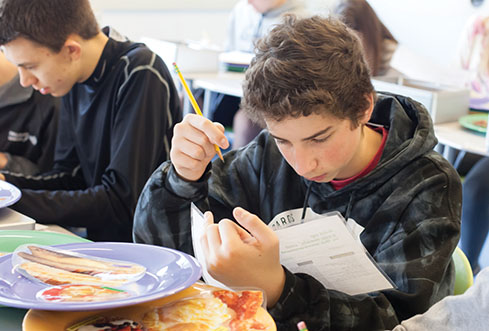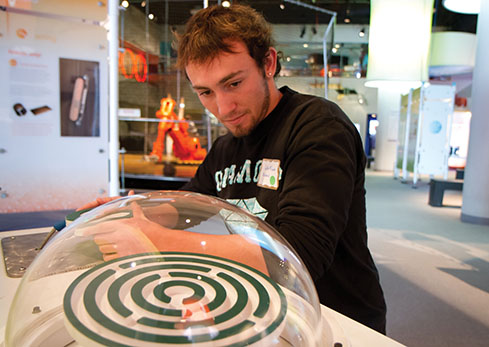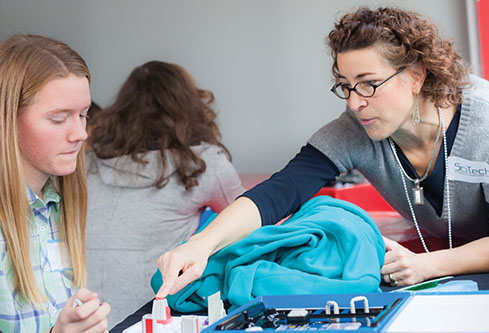 |
||||||||||||||||
|
I Can Do That
When area students take part in SciTech Days, they get to see themselves in a future fueled by science and technology. Inside Carnegie Science Center, students from Deer Lakes High School play forensic scientist as they examine paintings by Vincent van Gogh, Andy Warhol, and Claude Monet. The masterpieces look authentic, but are they the real McCoy? It’s hard to tell just by looking. Instructor Casey Hanner explains to the group of ninth graders how to determine the date of the paintings’ pigments using hard science. She hands out test results conducted in a museum lab, and shows the teens how to identify the hues based on their reactions to various chemicals. Fifteen-year-old Sarah quickly identifies the white paint in van Gogh’s Wheat Fields with Cypresses as titanium, and references a chart that says it was used from 1921 to 1975. But wait—Van Gogh created Wheat Fields in 1889. “It’s a fake,” she declares. “We have a fake!” Hanner echoes, notching it up several decibels. It’s fascinating discoveries like this that fill SciTech Days, a twice-annual, four-day interactive experience that brings middle and high school students together with the region’s leading science and technology professionals. It’s a mainstay program for the Science Center, attracting more than 4,000 students last fall, including 1,200 from rural and other underserved communities. This March 3-6, at least that many students are expected to descend upon the Science Center for hands-on lessons in everything from a crash course in nanotechnology to exploring a day in the life of Quasi the robot.
At an age when students begin to seriously consider their career options, SciTech Days offer a real-world glimpse into how STEM (science, technology, engineering, and math) skills are applied in the growth fields of the region, including biotech and health, nanotechnology and advanced materials, information technology, robotics, energy, and the environment. Through theater-style presentations, hands-on workshops, and one-on-one face time with STEM professionals from across the region, students get the rare opportunity to pick the brains of local scientists, and, in some cases, get a glimpse inside their workday. “It helps an impressive number of regional students grasp that STEM is important in their everyday lives and that exciting career opportunities are available to them in their own backyard,” says Linda Ortenzo, director of STEM programs at the Science Center. Ortenzo says the variety of experiences offered at SciTech Days—from 3D printing to bioengineering to investigating the possible spread of a dangerous organism— illustrates how puzzling through math and science problems in the classroom can later be applied to developing a new technology or finding a cure for a disease.
“It allows students to see the real-world applications,” she says. “They see a microcosm of STEM research in the region and learn that they can be part of a global hub of innovation.” SCIENCE FOR LIFEOf the 40 leading STEM companies and higher-education organizations that participate by lining the Science Center lobby with interactive exhibits, FedEx Ground and U.S. Steel Corporation are among the most popular. The draw at the FedEx table: Pairs of students race each other to determine who can scan a package the quickest and, in the process, learn about information technology and how it helps the carrier track packages through its far-flung system. Some kids hang around and talk to Matt Marangoni, a FedEx engineer, about what makes the intricate tracking system tick.
“When you think of FedEx, you probably think of someone delivering packages,” Marangoni, a wireless network engineer, tells the students. “But all of the equipment and scanners you see here help your package move. It’s all engineering, science, and math.” “We’re interested in sparking that interest early, and hooking them so that our young talent wants to stay and contribute to our community.”
- SEV MCMURTRY, SENIOR VICE PRESIDENT OF OPERATIONS PLANNING
|
||||||||||||||||
 |
|
|
In addition to fulfilling their commitment to community outreach, corporations in Pittsburgh participate in SciTech Days to help spark interest in STEM careers—a move that may pay dividends in future years as they recruit people for hard-to-fill jobs in engineering, science, and technology fields.
Over the next decade, an estimated one million STEM graduates will be needed in the United States, including 150,000 in western Pennsylvania. And not only will there be jobs waiting for STEM grads, they tend to be the ones with enviable salaries. Some 63 percent of the STEM workforce with an associate’s degree earn more than those with a bachelor’s degree in a non- STEM occupation while 47 percent of those with bachelor’s degrees in STEM occupations earn more than those with doctorate degrees in non-STEM careers.
“FedEx Ground was one of the original sponsors of SciTech, and I’m especially proud of that history and the program’s significant growth over the years, which speaks to demand,” says Sev McMurtry, senior vice president of operations planning and engineering at FedEx Ground and a Science Center board member. “There are well-paying STEM jobs in this region that go unfilled. So what we’re trying to do at SciTech Days is to show kids that math and science are all around you and can be fun. We’re interested in sparking that interest early, and hooking them so that our young talent wants to stay and contribute to our community.”
 |
|
|
All SciTech Days programming is linked to the recently formulated Next Generation Science Standards. Just as important, teachers say, the hands-on event gives them the opportunity “to bring to life what they’re teaching.” For more than 10 years, Betsy Killmeyer, a middle school science teacher at St. Bede’s School in Point Breeze, has made SciTech Days part of her curriculum.
“It gives students the opportunity to really see science through hands-on, fun activities,” she says. “It also shows students that you don’t have to be a doctor or an engineer to be a scientist. There are many fields where you can do and utilize science. Science doesn’t have to be scary.” Referring to the hit sitcom The Big Bang Theory, she adds, “You don’t have to be a Sheldon,” the show’s brainiac physicist.
Programs like SciTech Days are particularly crucial when students enter middle school, an age when interest in science wanes nationwide as kids gravitate towards social activities, Killmeyer says. She counteracts that trend with participation in SciTech Days and frequent trips to the Science Center. Another source of science pride: fielding teams in the Future City Competition, a national engineering competition sponsored regionally by the Science Center. Her teams have won nearly half of the 16 regional contests, and the boys and girls are equally enthusiastic. “We have pep rallies for it,” she says.
These activities also allow Killmeyer and her colleagues to stay abreast of the latest technological and scientific innovations and careers. “Teachers benefit, too,” she says. “You can’t be in science education and be static.”
CHANGING THE WORLD
Students’ eyes widen as they listen to Jeff Cooper, a 22-year-old software engineer at Google in Pittsburgh, describe the perks of his job. He’s giving career advice during an informal, fast-paced session dubbed Career Café, where students bound from table to table talking to industry leaders in the professional equivalent of speed dating.
“Google is a cool place to be,” he says. “They give us food. They give us video games in the office. They have a pool table. But that’s not why it’s a cool place. I started three months ago and I can tell what I’m doing is going to make a difference in the company.
“If we function more efficiently, our customers will get things a little faster, a little better,” he continues. “I can tell, in my first year, I will have an impact even in a company as big as Google, with tens of thousands of employees.”
John, 17, a senior at Penn-Trafford High School, walks away from the table inspired by Cooper’s brief talk.
 |
|
|
“I liked the Google guy,” he says. “He’s only 22. It’s nice to see someone so young and he’s already doing something in his field. Maybe I could be like that in four or five years.”
Some SciTech students already know exactly what they plan to study in college, while others haven’t a clue. Michael Zalich, a senior research chemist at PPG Industries, tells students not to stress out about an undecided major. “I didn’t declare a chemistry major until the end of my sophomore year,” he confides. “Find something you love, with the caveat you have to get paid. That’s important, too.”
Zalich says he enjoys talking with kids about opportunities that many would never consider. “It’s great to get them thinking of science at a young age,” says Zalich, noting that he met a young woman who was interested in both architecture and science, so he introduced her to synthetic organic chemistry. He told her, “You build molecules. You learn how to put together atoms to build molecules. You can use it for anything— a drug, new polymers.” He says the student was excited to explore this new idea. “I had never thought of that possibility,” he recalls her telling him.
Besides career shopping, students have fun experimenting with new technology at SciTech Days. In 3D Design and Printing, students watch as a 3D printer roughly the size of a sewing machine prints three-dimensional objects from digital files. Instructor Christopher Allen challenges students to use classroom computers to design a cup that would both be functional and creative. And he dangles a big incentive: The winning design will be created on the 3D printer and mailed to the creators.
 |
|
|
Nora and Maya, ninth graders at Seneca Valley High School, navigate the computer’s mouse to design a cup that resembles an upsidedown pyramid with a hole in it. Wearing T-shirts that say FEM STEM (a group that encourages girls to go into science and technology), they talk about their favorite subject—science.
Nora, an aspiring biologist, thinks out loud about how 3D printing could be useful for a myriad of industries. “I’ve watched documentaries about people dying from having to wait for organs,” she says. “This way you wouldn’t have to wait for a new organ.”
“It’s revolutionary,” adds Maya, an aspiring emergency room physician.
The girls say they love coming to SciTech Days. “It’s really good at getting kids interested in science,” Maya says. “Science is what’s going to change the world. Instead of complaining to their parents, kids can use science to make the world what they want it to be.”
Three Rivers Wise · Call of the Wild · Uncrated: The Hidden Lives of Artworks · President's Note · NewsWorthy · Face Time: Stefan Hoffmann · Artistic License: A Wonderful (Still) Life · First Person: Objects of Remembering · Science & Nature: Nights at the Museum · Travel Log · The Big Picture
 |
Copyright © 2017 CARNEGIE Magazine. All rights reserved. |



